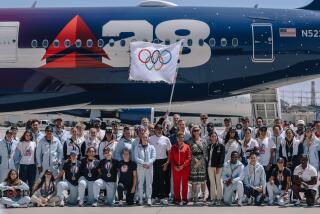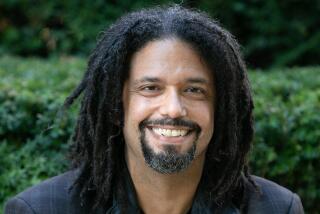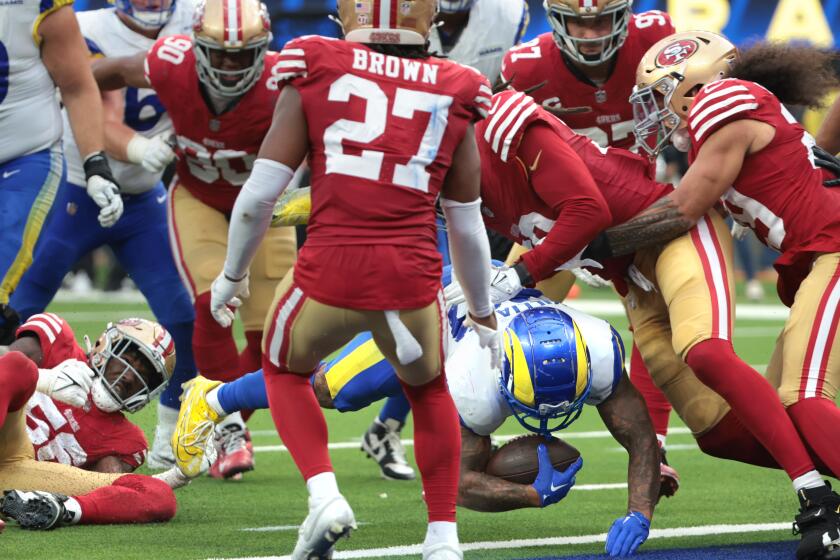L.A. and the Olympics were a golden match
During the Los Angeles riots in 1992, the Amateur Athletic Foundation on Adams Avenue was on the edge of danger. Unarmed guards with nothing more than their uniforms and a plea for reason kept the building and its extensive grounds safe by telling potential looters that the place was a museum for the city’s Olympic history.
Even the rioters seemed to understand. Los Angeles is an Olympic city.
The history and artifacts of its accomplishments in that regard are special, to be cherished and celebrated, not looted. Los Angeles has millions of people, from thousands of places, speaking hundreds of languages. But the Olympic Games look, feel and sound the same to all.
Twice, they have been held here, in 1932 and 1984. Both times, they have been aesthetic and financial successes.
The Coliseum of the 1932 Games gave the city a landmark for the rest of the century, and beyond. Opened in 1923, it still remains, its peristyle end distinctive in architecture and historic in the plaques it houses to memorialize great people who have passed that way.
The ’84 Games put makeup and high heels on the matronly old Coliseum and gave the city, and the world, opening and closing ceremonies that showcased her graceful aging, as well as the genius of producer David Wolper. When those Games ended, there was no question which major world city had Hollywood as a suburb.
The ’32 Games, according to documents and best estimates, made a profit of $1 million, a startling sum then. The 1984 Olympics, whose well-documented financial success left the legacy that has become that Amateur Athletic Foundation library and museum on Adams Avenue, as well as showcasing the genius of its organizational leader Peter Ueberroth, made a profit of $232.5 million, a startling sum then.
In the aftermath of the ’32 Games, Olympic historians wrote that Los Angeles had shown the world how to throw a great party and still leave with a nice fat wallet. In the aftermath of the ’84 Games, Olympic historians were more blunt, and remain so today. The ’84 Games saved the Olympic movement, they said.
Before the ’84 Games, the number of cities bidding to host were dwindling — Los Angeles won the right to stage the ’84 Games when the only other bidder, Tehran, withdrew.
Now, with the Los Angeles model for financial success, the bidding cities figuratively line up around the block outside International Olympic Committee headquarters in Lausanne, Switzerland. So do television networks worldwide, and especially in the United States, which vie to pay gobs of money to show the Games.
William May Garland, a wealthy businessman, ran the ’32 Games for Los Angeles. His successful production earned him a rare honor, the Olympic Cup, usually presented to a committee, municipality or country.
Ueberroth, who ran the ’84 Games, was also a businessman, although not in the moneyed category of Garland.
He took over the post after local lawyer John Argue and Mayor Tom Bradley had done much of the political heavy lifting to acquire the Games. Ueberroth, with his deputy Harry Usher, ran an Olympics that unified a massive city like few things before and even made traffic tolerable for 16 days. His successful production earned him a rare honor. He was selected Time magazine’s “Man of the Year.” He is now chief executive of the United States Olympic Committee.
The success of star sprinter Eddie Tolan was accompanied by controversy in the ’32 Games. He won gold medals in the 100 and 200 meters, but the 200 was disputed because Ralph Metcalfe, who finished with the bronze medal, was made to dig his starting spot several feet away from the correct place on the line. No fancy starting blocks in those days.
The success of star sprinter Carl Lewis was accompanied by controversy in the ’84 Games. He won gold medals in the 100, 200 and 400 relay, in which he ran an 8.94-second anchor leg, and the long jump. But his long jump victory, although not disputed, was controversial because Lewis, after making what he perceived to be a jump good enough for the gold medal, passed on further attempts, bringing boos from the Coliseum crowd that had paid to see him perform.
The ’32 Games were referred to in at least one 1948 newspaper story as “The International Pigtails Classic.” The article said the Los Angeles Games “brought out such sensational teenage stars as Mildred ‘Babe’ Didrikson, the skinny kid from Texas, who set a world record in the hurdles, an Olympic record in the javelin throw and took second in the high jump; Eleanor Holm in swimming and Dorothy Poynton in diving.”
Didrikson, who also competed in various stages of her athletic career as Babe Didrikson Zaharias, became an early inspiration to female athletes with her Olympic performance.
She won two of the six events contested for women in track and field but actually surpassed world records in three. Her 80-meter and javelin gold medals and marks were without dispute, but when she set the record in the high jump, judges ruled that she had used an illegal dive technique. She cleared the highest height, but Jean Smiley got the gold and Didrikson the silver.
In ‘84, there were 16 events for women in track and field, and dozens more in other sports. UCLA’s Jackie Joyner was second in the heptathlon and fifth in the long jump; Evelyn Ashford and Valerie Brisco-Hooks were gold medalists in the sprints, and Joan Benoit won the first women’s marathon, an event that the more chauvinistic of Olympic officials had opposed, suggesting that women weren’t strong enough to compete at 26.2 miles.
And for a frightening few minutes, the naysayers were nearly proved correct. Well after Benoit had entered the Coliseum for her triumphant final lap, Gabriele Andersen-Scheiss, an American competing for her native Switzerland, entered the Coliseum in a strange, contorted gait. She was suffering from heat prostration and had lost the normal use of her limbs. Somehow, she made it across the finish line and collapsed. In less than two hours, however, she had recovered.
The most controversial moment of the ’84 Games also occurred in a women’s event. American Mary Decker Slaney, running in the 3,000 meters, tripped on the foot of teenager Zola Budd, a South African who ran barefoot and who had been involved in a controversial last-minute change of citizenship to compete for Britain. Slaney fell and her anticipated gold medal was lost. Budd, stunned by what had happened, faded badly and also failed to get a medal.
The credit for starting the Los Angeles connection to the Olympics should go to Garland, according to David Simon.
Simon, president of the Los Angeles Sports Council, a long-time member of the Southern California Committee for the Olympic Games (SCCOG) and one of the first people joining Ueberroth on the Los Angeles Olympic Organizing Committee, said that Garland, in 1920, was part of a local group looking to throw a festival in the city.
“At one of their meetings,” Simon recalled from his research, “the Olympic Games came up. Garland said that, since he was going to Europe on an extended trip, anyway, he would go to the Antwerp Games and talk to some people there.”
The IOC people who met with Garland told him that they would consider his city if it had a stadium. He brought the word back and the Coliseum project began.
“Many people are under the impression that L.A. had already been awarded the Games and then, with that promise, began building the Coliseum,” Simon said. “Not so. It was built with the speculation that we would get the Games, but there were no guarantees.”
In 1923, Garland went back to the IOC with a proposal for his city to play host to the Olympics. Soon, the IOC had awarded the ’28 Games to Amsterdam and the ’32 Games to Los Angeles.
“There is a great picture,” Simon said. “It shows William May Garland, standing at a map and pointing to Los Angeles, to show the Olympic people where it was.”
The legacy and local mandate was also maintained by Cliff Argue, a Los Angeles lawyer, who had competed in the pentathlon in the Paris Games of 1924. He became active in Olympic activity here both before and after the ’32 Games. He passed this civic torch to his son, John, who carried it as president of the SCCOG for 20 years. John C. Argue died in 2002. His son, John M. Argue, is currently a member of the SCCOG.
Once Garland got his city on the Olympic path, it never got off.
In 1939, the IOC, with Games headed for Tokyo and war looming, knew it had a problem, so it called its old friend, Garland, and asked for a proposal for Los Angeles, just in case. Wartime quickly wiped out any thoughts of athletic competitions for 1940 and 1944, the Olympics not returning until 1948 in London. But Garland’s proposal became the basis for the creation of the SCCOG.
The SCCOG bid on every Summer Games from 1948 through 1984, and took its most recent shot with a formal bid for the 2012 Games. That bid failed to get beyond the USOC, which now has selection control over its country’s bid. New York was made the United States’ city, and it lost to London.
The actual bid process for the 2016 Games has not begun, but the SCCOG, with attorney Barry Sanders its chief executive, is in the starting blocks.
Los Angeles is also uniquely positioned to be an emergency choice for an Olympics, in case of the financial, organizational or political meltdown of a chosen city. The option of moving the Games from Athens to Los Angeles was discussed before the 2004 Games.
The major expense for an Olympic city is construction of facilities. In 1984, a major component of the eventual bottom line was the number of existing facilities. As Ueberroth once said, it costs much less to rent than to build. And since it last staged the Games, Los Angeles has upgraded its sports infrastructure impressively. Since 1984, Staples Center has been built, as have the Home Depot Center in Carson, the Pond in Anaheim and the Pyramid in Long Beach. USC’s Galen Center is set to open later this year.
When the SCCOG made its bid for the 2012 Olympics, it proposed using 36 area venues. Of those, only 14 were used in 1984.
Clearly, the Olympics are in this city’s blood. Los Angeles is proud of itself, of its weather, location, culture, temperament and influence. Some cities want to be left alone. Los Angeles wants the world to visit. A poll taken by the SCCOG in 2001, in preparation for its bid for 2012, showed that 84% of Angelenos questioned were in favor of having the Games back.
In the midst of the ’32 Games, at a controversial moment in the Coliseum involving a foreign athlete, Bill Henry, working as the public-address announcer, leaned forward to the microphone. Henry had been among the earliest sports editors of the Los Angeles Times and had left that post to join the Olympic Organizing Committee, becoming sports technical director for the ’32 Olympics.
As the boos for the foreigners rang out, Henry put a stop to it with a message that was as appropriate to this city’s Olympic standards then as it is today.
“Ladies and gentlemen,” Henry scolded, “remember, these people are our guests.”
Times editorial assistant Jennifer Preece contributed to this report.
More to Read
Go beyond the scoreboard
Get the latest on L.A.'s teams in the daily Sports Report newsletter.
You may occasionally receive promotional content from the Los Angeles Times.











